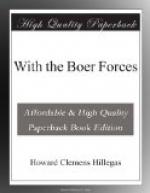After four hours of trekking over veld, kopje, sluit, and donga, the two columns halted, the burghers dismounted, and, weary from the long journey and the lack of sleep, lay down on the earth beside their horses. Commandants, field-cornets and corporals, bustling about among the burghers, horses and waggons, gave orders in undertones; generals summoned their scouts and asked for detailed information concerning the whereabouts of the enemy; patrols were scurrying hither and thither to secure accurate ideas of the topography of the territory in front of them; all who were in authority were busy, while the burghers, who carried the strength of battle in their bodies, lay sleeping and resting.
The first dim rays of the day came over the tops of the eastern hills when the burghers were aroused and asked to proceed to the positions chosen by their leaders. The men under Peter De Wet, the younger brother of the Commandant-General, were led to an elevation about a mile and a half south of Sannaspost, where they placed their cannon into position and waited for the break of day.
Christian De Wet and his five hundred burghers advanced noiselessly and occupied the dry bed of Koorn Spruit, a stream which crossed the main road running from Thaba N’Chu to Bloemfontein at right angles about a mile from the station where the British forces had begun their bivouac for the night, two hours before. No signs of the enemy could be seen; there were no pickets, no outposts, and none of the usual safeguards of an army, and for some time the Boers were led to believe that the British force had been allowed to escape unharmed.
The burghers under the leadership of Christian De Wet were completely concealed in the spruit. The high banks might have been held by the forces of their enemy, but unless they crept to the edge and looked down into the stream they would not have been able to discover the presence of the Boers. Where the road crossed the stream deep approaches had been dug into the banks in order to facilitate the passage of conveyances—a “drift” it is called in South Africa—and on either side for a distance of a mile, up and down the stream, the burghers stood by their horses and waited for the coming of the day. The concealment was perfect; no specially constructed trenches could have served the purposes of the Boers more advantageously.
Dawn lighted the flat-topped kopjes that lay in a huge semicircle in the distance, and men clambered up the sides of the spruit to ascertain the camp of the enemy. The white smoke-stack of the Bloemfontein waterworks appeared against the black background of the hills in the east, but it was still too dark to distinguish objects on the ground beneath it. A group of burghers in the spruit, absent-mindedly, began to sing a deep-toned psalm, but the stern order of a commandant quickly ended their matutinal song. A donkey in an ammunition waggon brayed vociferously, and a dozen men, fearful lest the enemy should hear the noise, sprang upon him with clubs and whips, and even attempted to close his mouth by force of hands. It was the fateful moment before the battle, and men acted strangely. Some walked nervously up and down, others dropped on their knees and prayed, a few lighted their pipes, many sat on the ground and looked vacantly into space, while some of the younger burghers joked and laughed.




